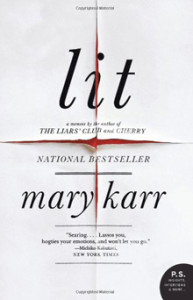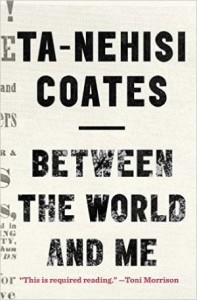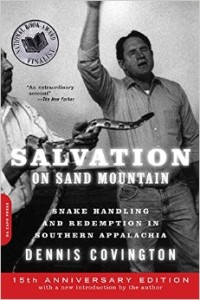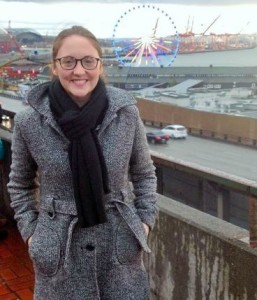One of our fundamental convictions at The Seattle School is that everybody has a story to tell. But how do we craft meaningful stories? And how can we tell stories in a way that might offer a glimpse of deep truth and goodness? That’s why we’re thrilled to offer Memoir as Art and Spiritual Practice (SFD 575) as part of the Fall 2015 curriculum. Here we introduce the course instructor, Dyana Herron, MFA, and talk with her about the unique qualities of the memoir genre and why she’s excited to lead this class.
Can you tell us a little about your background?
I grew up and went to college in southeast Tennessee. My hometown, Cleveland, is fairly small but is the world headquarters of a Pentecostal denomination called the Church of God. Cleveland hosts a massive Halloween party each year where I once saw Little Richard perform, and serves an excellent variety of milkshakes at this tiny place called Dari Kreme.
It’s a wonderful town in the Appalachian foothills, and my family all still live there and think it’s strange that I don’t. But I left in my twenties after completing a low-residency MFA in Creative Writing at Seattle Pacific University (SPU) and since then have lived in Boston, then Seattle, then Philadelphia, and now Seattle again. I returned to Seattle last year for a writing fellowship that allowed me to work on my own memoir and teach creative writing at SPU (after a few years teaching part-time at Eastern University and The King’s College), where I work now in the School of Education.
And how did you end up connecting with The Seattle School?
During my first years in Seattle I worked for Image Journal, an arts and faith organization, and while living in Philly worked as creative writing editor for The Other Journal, which is based at The Seattle School: within these realms my personal sphere and The Seattle School kept overlapping. I was formally introduced to The Seattle School as a possible instructor for this course by Gregory Wolfe, the editor and publisher of Image. I’m really happy to have the opportunity to participate in this community in a more direct way this fall.
Oh, and my therapist graduated from The Seattle School! He’s the best.
So this memoir class—what’s it all about?
The official title is Memoir as Art and Spiritual Practice. We’ll discuss what is meant by “art” and “spiritual practice,” but there will be an emphasis on memoir as a product that is intentionally shaped using literary techniques. It’s true material that is “manipulated,” hopefully in a way that enhances that truth, which is a kind of work that has all kinds of implications for spiritual practice. Beyond personal expression we’ll also examine memoir as cultural artifact. Each week we’ll read books or essays around a variety of themes—Place, Family, Body, Ethnicity & Cultural Identity, and more—in conjunction with studying one or two craft elements. Then students will put these techniques into practice by drafting, workshopping, and revising their own personal narratives.
It’s exciting to teach this course at The Seattle School, where students already engage so thoroughly with their personal stories. My hope is that this course expands upon that experience to teach students about how that practice can be translated into literature, and gives them a deeper understanding of the genre’s possibilities.
What are you most looking forward to about teaching this class?
Hands down, meeting the students and engaging this material (which I consider to be really important, potentially transformational work) with them. Teaching creative writing is a privilege because being imaginative—whether that’s through writing personal nonfiction, fiction, poetry, or creating other types of art—requires a lot of vulnerability and bravery. It’s inspiring to me to see students willing to undergo that process, and it’s an honor to be allowed to travel alongside them during it. It definitely feeds my own practice, and hopefully they take something away from it as well.
Are there any favorite books that you find particularly useful or inspiring in your writing and teaching?
 I’m so excited about the readings we’re going to cover in the course, some of which are old favorites of mine, and some that are new to me. We’ll be looking at Mary Karry’s Lit, which is an excellent example of someone with the bravery to expose her “shadow self”; it is also a conversion narrative. We’ll read Amy Fusselman’s memoir 8, which is a little firecracker of a book. In it she talks about abandoning traditional therapy for craniosacral therapy in an effort to confront pain from childhood sexual abuse: she wants someone to lay hands on her, wants to learn how touch from a stranger can be healing, not harmful. But it’s also about motherhood and ice skating and monster trucks and the Beastie Boys and the nature of time. She’s one of my favorites but few people have heard of her so I’m always excited to introduce her to students. I’m really looking forward to digging into Ta-Nehisi Coates’s new book Between the World and Me. We’ll read Dennis Covington’s account of handling snakes in a church service in Salvation on Sand Mountain. We’ll also look at two essays by David Sedaris, because I’m personally very interested in the use of humor to write about painful experiences—when that might be helpful, and why.
I’m so excited about the readings we’re going to cover in the course, some of which are old favorites of mine, and some that are new to me. We’ll be looking at Mary Karry’s Lit, which is an excellent example of someone with the bravery to expose her “shadow self”; it is also a conversion narrative. We’ll read Amy Fusselman’s memoir 8, which is a little firecracker of a book. In it she talks about abandoning traditional therapy for craniosacral therapy in an effort to confront pain from childhood sexual abuse: she wants someone to lay hands on her, wants to learn how touch from a stranger can be healing, not harmful. But it’s also about motherhood and ice skating and monster trucks and the Beastie Boys and the nature of time. She’s one of my favorites but few people have heard of her so I’m always excited to introduce her to students. I’m really looking forward to digging into Ta-Nehisi Coates’s new book Between the World and Me. We’ll read Dennis Covington’s account of handling snakes in a church service in Salvation on Sand Mountain. We’ll also look at two essays by David Sedaris, because I’m personally very interested in the use of humor to write about painful experiences—when that might be helpful, and why.
It seems like memoirs are uniquely capable of wrestling with spirituality as it interacts with our day-to-day lives. Why do you think this is?
Memoirs recount details of our day-to-day lives—what happens externally to us—but I believe that all great memoirs are written by authors who are willing to turn that lens inward and take a long, hard look at the self. Not all memoirs accomplish this, mind you, but all good ones do—the authors are deeply self-aware and willing not only to look but to share with others a multi-dimensional view of themselves, including what Fr. Richard Rohr and others might call “the shadow self.” I believe that going to that place of self-examination a little (or a lot!) beyond where the ego wants us to stop is the way we can make significant gains both in our personal lives and in our art: and it’s what readers will recognize and respond to as well. Lots of people can write well, lots of people have an extraordinary or painful story to tell, and lots of people are more than willing to cast a critical eye to the world around them, but not everyone will extend themselves to this place of radical self-honesty (which, hopefully, ultimately leads to a deeper level of self-love). When we are able to get there, lots of spiritual and theological questions are waiting.
 I know this is true because I have experienced it. When I applied to the writing fellowship I held last year, my intended project was to write about my family’s experience a couple of years ago when my younger brother was sentenced to federal prison. I wanted to give my brother a voice and tell his story and the story of others in similar situations. But of course I found that this was impossible—I could only tell my own story, which includes my love for him, but is separate from him. That’s one of the devastating things about love, I suppose—we are always separate from that which is beloved to us, although the heart longs for unification. That is a spiritual condition too.
I know this is true because I have experienced it. When I applied to the writing fellowship I held last year, my intended project was to write about my family’s experience a couple of years ago when my younger brother was sentenced to federal prison. I wanted to give my brother a voice and tell his story and the story of others in similar situations. But of course I found that this was impossible—I could only tell my own story, which includes my love for him, but is separate from him. That’s one of the devastating things about love, I suppose—we are always separate from that which is beloved to us, although the heart longs for unification. That is a spiritual condition too.
We talk a lot about intersections at The Seattle School—like theology and psychology, or text, soul, and culture. How do you see this class adding to those conversations?
Memoir is a practice located at the intersection of many seemingly irreconcilable dichotomies, and is an exercise in holding those oppositions in tension: truth and artifice, creation and destruction, the past and the present, the self and the other, and the absolute uniqueness of our personal experience coupled with the undeniable truth that there is nothing new under the sun. What a wonderful form, that mirrors the paradoxical nature of our experiences! That’s what makes it such a challenge, and an art: it’s not an easy thing to take something as chaotic as life and give it structure and form while maintaining the truth of its essence.
I’m also interested in ways that memoir intersects with the practice of narrative therapy. I’m not a psychologist, but it seems obvious that writing one’s story—and beyond that, crafting one’s story—can be an empowering process, and a healing one. When we write, we are allowed to be in total control of situations that may have left us feeling out of control or broken when they occurred. We are also allowed to honor (you could even say “bless”) the characters and events that populate our lives. We are encouraged to find metaphorical meaning and identify themes in our lives that make our narratives feel more coherent, which may also lead to a more integrated sense of self.
 What’s your hope for how students might be changed after taking this class?
What’s your hope for how students might be changed after taking this class?
I’ve already gushed quite a bit about the potential for writing memoir to challenge and change the writer. I hope that happens for the students, but I know those types of things happen at different times for different people. I was so stressed during graduate school—I don’t remember feeling very inspired or enlightened until I was a couple years out of the program working on non-required projects. What I do hope students take away from the class is a better understanding of literary techniques involved in crafting a memoir, so they know good writing isn’t just something that comes from inspiration, though there is certainly a place for that. I like for that process to be demystified a bit, and for students to learn how to make conscious choices about things like tense, point of view, detail selection, etc., that will give them control over how their stories are presented. I also hope they fall in love with at least one of the readings!
And on a lighter note, what have you been enjoying these days?
This is embarrassing; I watch the worst TV. On Netflix I just finished Dance Academy, an Australian series about a group of high schoolers who are competing for spaces in the National Ballet, but who, along the way, learn that friendship is more important than ambition. It’s exactly as it sounds, and I loved it. I try to keep my viewing light. Before that, also on Netflix, I watched a series called Dogs with Jobs, which is about dogs who have jobs—all different kinds of dogs, all different kinds of jobs. I love dogs and the day I get one will be close to the happiest day of my life. Now when I see a dog on the street I think, “Do you have a job?” It’s wonderful.


